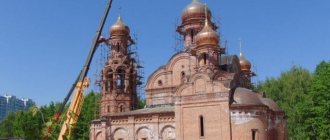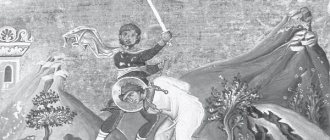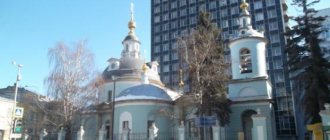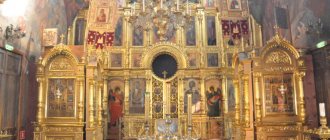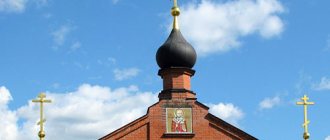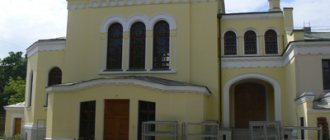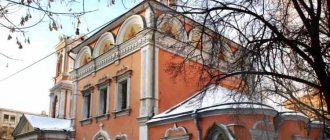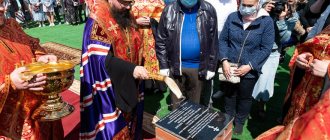Mir
Russia Moscow Church of Barbara the Great Martyr on Varvarka (Moscow) Map is loading…
{"format":"leaflet","minzoom":false,"maxzoom":false,"limit":50,"offset":0,"link":"all","sort":[""], "order":[],"headers":"show","mainlabel":"","intro":"","outro":"","searchlabel":"\u2026 \u0441\u043b\u0435\ u0434\u0443\u044e\u0449\u0438\u0435 \u0440\u0435\u0437\u0443\u043b\u044c\u0442\u0430\u0442\u044b","default":"","import-annotation":false,"width ":"auto","height":"350px","centre":{"text":"","title":"""link":"""lat":55.75233300000000014051693142391741275787353515625,"lon": 37.6258610000000004447429091669619083404541015625,"icon":""},"title":"","label":"","icon":"","lines":[],"polygons":[],"circles":[ ],"rectangles":[],"copycoords":false,"static":false,"zoom":8,"defzoom":14,"layers":["OpenStreetMap"],"image layers":[] ,"overlays":[],"resizable":false,"fullscreen":true,"scrollwheelzoom":true,"cluster":false,"clustermaxzoom":9,"clusterzoomonclick":true,"clustermaxradius":80, "clusterspiderfy":true,"geojson":"","clicktarget":"","showtitle":true,"hidenamespace":false,"template":"","userparam":"","activeicon": "","pagelabel":false,"ajaxcoordproperty":"","ajaxquery":"","locations":[{"text":"\u003Cb\u003E\u003Ca href=\"/palomnik/%D0% A5%D1%80%D0%B0%D0%BC_%D0%92%D0%B0%D1%80%D0%B2%D0%B0%D1%80%D1%8B_%D0%92%D0%B5% D0%BB%D0%B8%D0%BA%D0%BE%D0%BC%D1%83%D1%87%D0%B5%D0%BD%D0%B8%D1%86%D1%8B_%D0% BD%D0%B0_%D0%92%D0%B0%D1%80%D0%B2%D0%B0%D1%80%D0%BA%D0%B5_(%D0%9C%D0%BE%D1%81 %D0%BA%D0%B2%D0%B0)\» title=\»\u0425\u0440\u0430\u043c \u0412\u0430\u0440\u0432\u0430\u0440\u044b \u0412\u0435\u043b\u0438\ u043a\u043e\u043c\u0443\u0447\u0435\u043d\u0438\u0446\u044b \u043d\u0430 \u0412\u0430\u0440\u0432\u0430\u0440\u043a\u0435 (\u 041c\u043e\u0441\u043a\u0432 \u0430)\»\u003E\u0425\u0440\u0430\u043c \u0412\u0430\u0440\u0432\u0430\u0440\u044b \u0412\u0435\u043b\u0438\u043a\u043e\u04 3c\u0443\u0447\u0435\ u043d\u0438\u0446\u044b \u043d\u0430 \u0412\u0430\u0440\u0432\u0430\u0440\u043a\u0435 (\u041c\u043e\u0441\u043a\u0432\u0430)\ u003C/a\u003E\u003C/ b\u003E\u003Chr /\u003E\u003Ca href=\"/palomnik/%D0%A1%D0%B2%D0%BE%D0%B9%D1%81%D1%82%D0%B2%D0%BE: %D0%90%D0%BD%D0%BD%D0%BE%D1%82%D0%B0%D1%86%D0%B8%D1%8F\" title=\"\u0421\u0432\u043e\u0439 \u0441\u0442\u0432\u043e:\u0410\u043d\u043d\u043e\u0442\u0430\u0446\u0438\u044f\u003E\u0410\u043d\u043d\u043e\u0442\u0430 \u0446\u0438\u044f\ u003C/a\u003E: "'\u0425\u0440\u0430\u043c \u0412\u0430\u0440\u0432\u0430\u0440\u044b \u0412\u0435\u043b\u0438\u043a\u043e\u0 43c\u0443\u0447\u0435 \u043d\u0438\u0446\u044b \u043d\u0430 \u0412\u0430\u0440\u0432\u0430\u0440\u043a\u0435\u003Cspan class=\»smw-highlighter\» data-type=\»2\» data- state=\»persistent\» data-title=\»\u0418\u043d\u0444\u043e\u0440\u043c\u0430\u0446\u0438\u044f\» title=\»\u0026#039;\u0026#039;\ u0026#039;\u0425\u0440\u0430\u043c \u0412\u0430\u0440\u0432\u0430\u0440\u044b \u0412\u0435\u043b\u0438\u043a\u043e\u043c\u04 43\u0447\u0435\u043d\u0438 \u0446\u044b \u043d\u0430 \u0412\u0430\u0440\u0432\u0430\u0440\u043a\u0435\u0026#039;\u0026#039;\u0026#039; 2014 \u0440\u0441\u043a\u043e\u0433 \u043e\u0431\u043b\u0430\u0433\u043e\u0447\u0438\u043d\u0438\u044f \u041c\u043e\u0441\u043a\u043e\u0432\u0441\u043a\u043e\ u0439\u0433\u043e\u0440\u043e \u0434\u0441\u043a\u043e\u0439 \u0435\u043f\u0430\u0440\u0445\u0438\u0438. \u0425\u0440\u0430\u043c \u0440\u0430\u0441\u043f\u043e\u043b\u043e\u0436\u0435\u043d \u0432 \u0440\u0430\u0439\u043e\u043d \u0435\u0422\u0432\u0435\u0440 \u0441\u043a\u043e\u0439, \u0426\u0435\u043d\u0442\u0440\u0430\u043b\u044c\u043d\u043e\u0433\u043e \u0430\u0434\u043c\u0438 \u043d\u0438\u0441\u0442\ u0440\u0430\u0442\u0438\u0432\u043d\u043e\u0433\u043e \u043e\u043a\u0440\u0443\u0433\u0430 \u0433\u043e\u0440\u043e\u0434\u0 430\u041c\u043e\u0441\u043a\ u0432\u044b. \u0421\u0432\u044f\u0442\u044b\u043d\u044f \u0445\u0440\u0430\u043c\u0430 - \u0438\u043a\u043e\u043d\u0430 \u0432\u0435\u043 b\u0438\u043a\u043e\u043c\ u0443\u0447\u0435\u043d\u0438\u0446\u044b \u0412\u0430\u0440\u0432\u0430\u0440\u044b \u0441 \u0447\u0430\u0441\u0442\u0438\u 0446\u0435\u0439\u043c\u043e\ u0449\u0435\u0439.\»\u003E\u003Cspan class=\»smwtext\»\u003E \u2026 \u003C/span\u003E\u003Cspan class=\»smwttcontent\»\u003E»'\u0425\u0440\u0430\u043 c \u0412\u0430\u0440\u0432\u0430\u0440\u044b \u0412\u0435\u043b\u0438\u043a\u043e\u043c\u0443\u0447\u0435\u043d\u0438\u0446\u 044b\u043d\u0430\u0412\u0430 \u0440\u0432\u0430\u0440\u043a\u0435"' \u2014 \u043f\u0440\u0430\u0432\u043e\u0441\u043b\u0430\u0432\u043d\u044b\u0439 \u04 45\u0440\u0430\u043c\u0418 \u0432\u0435\u0440\u0441\u043a\u043e\u0433\u043e \u0431\u043b\u0430\u0433\u043e\u0447\u0438\u043d\u0438\u044f \u041c\u043e\ u0441\u043a\u043e\u0432\u0441 \u043a\u043e\u0439 \u0433\u043e\u0440\u043e\u0434\u0441\u043a\u043e\u0439 \u0435\u043f\u0430\u0440\u0445\u0438\u0438. \u0425\u0440\u0430\u043c \u0440\u0430\u0441\u043f\u043e\u043b\u043e\u0436\u0435\u043d \u0432 \u0440\u0430\u0439\u043e\u043d \u0435\u0422\u0432\u0435\u0440 \u0441\u043a\u043e\u0439, \u0426\u0435\u043d\u0442\u0440\u0430\u043b\u044c\u043d\u043e\u0433\u043e \u0430\u0434\u043c\u0438 \u043d\u0438\u0441\u0442\ u0440\u0430\u0442\u0438\u0432\u043d\u043e\u0433\u043e \u043e\u043a\u0440\u0443\u0433\u0430 \u0433\u043e\u0440\u043e\u0434\u0 430\u041c\u043e\u0441\u043a\ u0432\u044b. \u0421\u0432\u044f\u0442\u044b\u043d\u044f \u0445\u0440\u0430\u043c\u0430 - \u0438\u043a\u043e\u043d\u0430 \u0432\u0435\u043 b\u0438\u043a\u043e\u043c\ u0443\u0447\u0435\u043d\u0438\u0446\u044b \u0412\u0430\u0440\u0432\u0430\u0440\u044b \u0441 \u0447\u0430\u0441\u0442\u0438\u 0446\u0435\u0439\u043c\u043e\ u0449\u0435\u0439.\u003C/span\u003E\u003C/span\u003E\u0430 \u0432\u0435\u043b\u0438\u043a\u043e\u043c\u0443\u0447\u0435\u043d\u0 438\u0446\u044b\u0412 \u0430\u0440\u0432\u0430\u0440\u044b \u0441 \u0447\u0430\u0441\u0442\u0438\u0446\u0435\u0439 \u043c\u043e\u0449\u0435\u0439 .","title":"\u0425 \u0440\u0430\u043c \u0412\u0430\u0440\u0432\u0430\u0440\u044b \u0412\u0435\u043b\u0438\u043a\u043e\u043c\u0443\u0447\u0435\ u043d\u0438\u0446\u044b\u043d \u0430 \u0412\u0430\u0440\u0432\u0430\u0440\u043a\u0435 (\u041c\u043e\u0441\u043a\u0432\u0430)","link":"""lat":55.7523330000000001 4051693142391741275787353515625,"lon" :37.6258610000000004447429091669619083404541015625,"icon":""}],"imageLayers":[]}
55.752268; 37.625954
Russia, Moscow, Varvarka street, 2
Moscow
Russia
Phone fax
: (495) 698-33-98
Church of Barbara the Great Martyr on Varvarka
- Orthodox church of the Iveron deanery of the Moscow city diocese. The temple is located in the Tverskaya area, the Central Administrative District of Moscow. The shrine of the temple is the icon of the Great Martyr Barbara with a particle of her relics.
History[edit]
The Church of Barbara the Great Martyr supposedly existed back in the 14th century a little south of the modern church. In 1514, under the leadership of the Italian architect Aleviz the New, a stone building was built. In 1796-1801, artillery major Ivan Baryshnikov and Moscow merchant of the first guild N.A. Samgin ordered a new church building. It is being built by architect Rodion Kazakov. At the beginning of the 19th century, the writer John of Kandor was first a presbyter in the church and then an archpriest.
In 1812, the French used the temple as a stable. The building was badly damaged and was restored in the 1820s.
In the 1920s, the church was rebuilt and closed. In 1965-1967 it was restored, under the leadership of the architect G. A. Makarov the bell tower was restored.
In 1991, the Patriarchal Compound of churches in Zaryadye was established.
In 1995, the former church building was transferred to the Compound.
Patron Saint of the Temple
The temple was consecrated in honor of the Holy Great Martyr Barbara. This woman lived at the turn of the third and fourth centuries and was the daughter of the noble Phoenician Dioscorus. These were times of persecution of the Disciples of Christ, but Varvara sincerely believed and accepted Baptism. Her father found out about this and took her into custody, trying to get her daughter to renounce the Faith. But Varvara was adamant. Toga Dioscorus gave his daughter to the city authorities. By order of the ruler Martian, Varvara was brutally tortured. However, the Savior Himself appeared to the girl, he healed her wounds and told her not to be afraid of anything.
One day, a girl tortured in a dungeon was taken out into the street as a warning to all Christians. A woman named Iulinia came out of the crowd and began to denounce the tormentors. Juliana was also captured. Both Christian women were beheaded by order of Martian in 306.
Saint Barbara's Memorial Day is December 4th. This Saint is turned to for help in trade, as well as for healing from illnesses and wounds.
Kontakion, Troparion and Canon to the Holy Great Martyr Barbara
Troparion, tone 4
The all-blessed lamb, divinely illuminated by the light of the Holy Trinity. Having established the Trisolar in the font, in flight from the flattery of the fathers. And confessed the faith of Christ. To those honest Varvaro, grace was granted from above to heal all illnesses and ailments. Through the prayers of Christ God, save our soul.
Kontakion, tone 4
Even in the Trinity, which is piously sung ever since, following God, the passion-bearer, you left the Hellenic sacrifices. In the midst of the trial, the suffering Varvaro, the tormentors, did not fear the rebuke of God. Singing loudly and ever. I honor the Trinity as one Divinity.
Library of the Russian Faith Canon of the Holy Great Martyr Barbara →
Read online
Childhood and youth
Saint Barbara lived in the fourth century in the city of Iliopolis, now the territory of Turkey. Her mother died early, and her father was a rich and noble man, a convinced pagan. His name was Dioscorus. He loved his daughter very much, took care of her and did not want to lose her. Seeing that she was becoming a beauty as she grew older, Dioscorus decided to imprison her in a tower so that no one could see her. Maybe he was afraid that she would get married and leave him alone. Or maybe he was afraid that she would begin to communicate with Christians and would herself believe in Christ.
But everything happened just according to the will of God. Being alone in the tower, Varvara looked at the surrounding nature and indulged in thoughts: Who created such beauty? It can’t all happen on its own! She asked her maids, but they said that the world was created by the gods.
But Varvara came to the conclusion that the soulless idols that her father worshiped could not create such beauty. There must be an All-Wise and Almighty Creator here. This is how the Lord prepared her heart to accept faith.
“To Varvara for punishment”
In the middle of the 16th century, under Ivan the Terrible, trade contacts were established with England. In this regard, the tsar ordered the establishment of “English” and “Merchant” courtyards between the churches of St. Maximus the Blessed and Great Martyr Barbara, in which English merchants who came to Muscovy stayed. In the 16th–17th centuries, the street acquired an aristocratic character; several boyar courtyards appeared on it, as well as new churches and monastery farmsteads. In 1565–1567, boyar Nikita Romanov , the brother of Tsarina Anastasia Romanovna, the first wife of Ivan the Terrible, settled here. Before this, the boyar held a court on Bolshaya Nikitskaya, but was forced to leave it, since Nikitskaya became oprichnina territory. The Romanov estate on Varvarka was inherited by the boyar's son Fyodor Nikitich, who later became Patriarch Filaret and the father of the first monarch of the Romanov dynasty. During the Time of Troubles, his court received the nickname “siege”, which was associated with the difficult events of that period, including the Polish intervention in 1610–1612. The future Tsar Michael spent his childhood and youth in the “siege court.” The chambers of the Romanov boyars, rebuilt and updated many times, have generally retained their historical appearance to this day and are a valuable object of cultural and historical heritage. Currently, they house the Museum of the Moscow Boyars of the 16th–17th centuries, which is part of the State Historical Museum.
In the 17th century, the commercial importance of the street was increasingly emphasized. In 1641, Tsar Mikhail Fedorovich placed the stone Gostiny Dvor on it, next to which wooden shopping arcades were crowded together, forming the famous “Barbarian Sacrum” - one of the busiest and liveliest places in old Moscow.
The population in this place has always been diverse. The noblest people of the state lived on Varvarka, but at the same time the poor settled here, trying to be closer to one of the largest city trades. For a long time it was an extremely busy and crowded street with chaotic buildings. At the end of the 18th century, it was decided to give it a more comfortable appearance, for which purpose many dilapidated buildings and shacks were demolished. In 1791, the Church of the Resurrection in Bulgakov, located on the corner of Varvarka and Nikolsky Lane, was dismantled, since it did not fit into the general row of buildings and narrowed the roadway. Also, the appearance of the street was noticeably affected by the great fire of Moscow in 1812, during which all the wooden buildings located on it burned down. Soon, new houses, shops and shops appeared in place of the destroyed houses, but the construction was carried out mainly in stone. In particular, instead of Tsar Mikhail Fedorovich’s Gostiny Dvor, which had by that time become dilapidated, a new, more modern and spacious building was built. Soon, signs of Moscow merchants hung it on all sides, and the crowding of shops was still very high. This often led to fires, but the fires were always local and could be quickly extinguished thanks to special water tanks.
At the end of the street there was a wall of Kitay-Gorod with the Broken Gate. Nearby, in the Varvarskaya Tower, there was a chapel in honor of the Bogolyubskaya Icon of the Mother of God, reverently revered by the townspeople. The fortress wall in this place was so wide that the nuns looking after the chapel planted a vegetable garden on it and grew vegetables.
In the 19th century, Varvarka’s former reputation as a noisy but aristocratic street was completely lost. During that period, it became famous for its drinking establishments and various kinds of thieves and swindlers, which gave it a somewhat scandalous character.
After the October Revolution of 1917, during which there were street battles on Varvarka, trade continued here, and many warehouses were also located here.
In 1934, the wall of Kitay-Gorod and the Varvarsky Gate were dismantled. There is a reminder of them in the toponym that has survived to this day - Varvarskie Vorota Square.
During Soviet times, on Varvarka, renamed Stepan Razin Street, all residential buildings and even churches were turned into communal apartments. In the 1950s, residents began to move into more comfortable housing. Then most of the residential buildings on the street were demolished, and restoration work was carried out in the churches.
Church of St. Barbara in Kutna Hora
They say that in the entire Czech Republic there are only four Gothic cathedrals that can compare with each other. We visited all four. This is the Cathedral of St. Vitus in Prague Castle, St. Bartholomew in Kolin, the Church of the Virgin Mary in Sedlec and the Church of St. Barbarians in Kutna Hora. It is very difficult to compare them with each other. It seemed to me that the most outstanding one is the one from Prague. But the Gothic style there is half “neo” - the entire western part, including the two towers, was built in the 19th and 20th centuries. Each of these stunning temples is worthy of a separate story. And the first special report will be dedicated to the Basilica of St. Barbara.
Table of contents
Church of St. Barbara
This cathedral stands in Kutná Hora, on the highest point of the city. That is why it is visible from afar, crowning the panorama of the city with a royal three-headed crown.
When you walk towards it along the terrace along a steep cliff, you don’t pay attention to anything else. The gaze passes by the views of the city from the top of the hill, passes through the figures of saints located on the edge of the terrace and focuses only on the temple itself.
From a distance, the eye covers the entire northern part of the cathedral and perceives the temple as a whole, comparing it with the sky, because at this high point only clouds come into contact with the massive and, at the same time, airy volume of the basilica.
Church of St. Barbara. Architecture
Coming closer, the eye rests on the immense mass of the cathedral and begins to examine the details of stone filigree - turrets, lace arched windows, intricate pinnacles, cornices. If you walk around the cathedral and look at its western façade, some comparisons come to mind. (We have not yet seen St. Vitus in Prague). In the Kutnagorsk Cathedral there is something from the Church of St. Anna in Vilnius, although they are not comparable in scale. It is possible to even find some similarities with the monastery cathedral in Oliwa near Gdańsk. And to be honest, there is an association with a huge, good-natured bug, a cuttlefish, spreading its legs and firmly resting on the ground.
Or... with a royal crown. But this is our personal view, we do not at all impose it on the honorable public.
Church of St. Barbara. Dedication
Why is the temple dedicated specifically to Saint Barbara? Everything here is more than logical. The main attraction of Kutná Hora is the silver mines. After all, it was thanks to the mining of silver that the city could afford the construction of such a huge and majestic temple. The important thing is that Kutná Hora was inhabited mainly by miners who extracted silver ore.
When the Skarbnik of the Polish Wieliczka Salt Mine told us his story, he explained that St. Barbara is the patroness of all miners. They pray to her for a peaceful, calm death after confession and holy communion. Since ancient times, the mining craft has been associated with the risk of life, and miners turned to this saint so that she would save them from the horror of unrepentant death.
Church of St. Barbara. History of construction
On the outskirts of Kutna Hora there is a Cistercian monastery. We mentioned the good deeds of the order when we talked about the ossuary in Sedlec. They also remembered the colossal Church of the Assumption of the Virgin Mary, which the Cistercians built nearby. The Order owned rich deposits of silver ore and sought to spread its influence as widely as possible.
But the Kutnogorsk patricians were in no way inferior to the monastery in their ambitions. They also had plenty of wealth; the local nobility held part of the silver deposits in their hands. The secular aristocracy started building the Church of St. Barbara in defiance of its neighbors - the monks. She not only sought to show off her prestige by erecting a majestic basilica, but dreamed of surpassing the monastic building.
It is interesting that neither the Kolin (Kolin) nor the Kutnagorsk “city fathers” had any ecclesiastical justification, because there was never a bishop’s see there. But nevertheless, using the support of the king (paid for in hard silver coin, I believe), the nobility realized their claims in the construction of such a luxurious temple.
And so it turned out that the city, miners’ temple far surpassed the monastery’s in sophistication of architecture and luxury of decoration. It should be remembered that the Cistercians were limited by the strict framework of the monastic rules.
Church of St. Barbara. Architectural decoration
The city temple was not bound by any canons limiting the use of decorative elements. Hence the rich and unexpected design of the facades for Czech architecture, and the even clearer and more majestic appearance. The customers were clearly inspired by French sacred architecture.
Instead of massive, thick walls that bear the entire weight of the vault, the Church of St. Barbara is completely dissected by windows, through which light simply pours into the temple. Part of the load from the vault is distributed to the buttresses through the graceful arcs of the flying buttresses. Therefore, it became possible to cut through the walls with wide arches of windows.
The history of the construction of the temple is worthy of attention. It is replete with interesting moments; seemingly unexpected parallels arise in it. In the Basilica of St. Barbara you again encounter the work of masters whose creations decorate iconic places in the Czech Republic.
Church of St. Barbara. Architects
The beginning of construction dates back to the end of the 14th century. Kutna Hora, which had become rich in silver, sought to compete not only with the neighboring Cistercian monastery, but even with the capital itself. It is not for nothing that the architects of St. Vitus Cathedral in Prague also had a hand in the local church. The design of the temple changed several times. And how many architects worked on its construction! After all, it took more than 500 years to build!
Let's start with the fact that the son of the famous Peter Parler, whom we mentioned in Kolin, Jan, was the first designer of the temple. He planned that the cathedral would be twice as long. But financial difficulties, and then the beginning of the Hussite wars, delayed any construction work for almost a hundred years. Since 1482, work more or less resumed, local craftsmen even tried to follow the original project.
But the real breakthrough in the construction of the temple is associated with the name of Matvey Reisek, a Prague master who first worked as a drawing teacher at the Tyn School of Prague. And already in the capital he tried himself as an architect - he participated in the creation of the Powder Tower. Reisek covered the Kutnagorsk Cathedral with a vault. (The picture clearly shows the mesh vault of the presbytery - the creation of Reisek, 1499.) Matvey died in Kutna Hora in 1506 and work on his projects continued for another six years.
In 1512, Benedikt Reith arrived from Prague to Kutna Hora.
He already had the Prague Vladislav Hall on his account. The vault with which he covered the hall of the palace in Prague Castle was the largest unsupported secular structure in Europe. He showed himself to be a brilliant master in Kutna Hora as well. There is an opinion that during the construction of the Church of St. Barbara, the architect used his unrealized project for the design of the vault of the Cathedral of St. Vitus. The builder boldly changed the design of the basilica from a five-nave to a three-nave one and covered it with a vault with ring-shaped ribs. Currently, we can see the creations of both masters: Matvey Reisek and Benedikt Reith. (Pictured is the circular vault of Benedict Reith).
Church of St. Barbara. Jesuits
The next page in the history of the temple was written by the Jesuits. They modified a lot in accordance with the prevailing Baroque style at that time, which emphasized the greatness and power of the Catholic Church. However, the Jesuit texts recorded in the cathedral's stone book have hardly survived.
And again, for many decades not a single entry was made in the stone chronicle of the construction of the temple. The last point in the history of the creation of the cathedral was set only in 1905. And from the 50s of the 20th century, a gradual, step-by-step restoration began.
During the restoration work, new, hitherto unknown writings with the names of artists and architects were discovered, as well as amazing data about the technology and progress of the construction of the cathedral. Perhaps this is already material for serious historical and architectural work. We told what interested us. And we are forced to admit that for a modern person, a medieval cathedral is infinitely difficult to understand.
Perhaps we will write separately about the interior decoration of the temple - its paintings and chapels will tell extraordinary stories. And, undoubtedly, there will be a story (or two) about Kutna Hora - the history of this city is like an adventure novel.
Photos
The Church of the Holy Great Martyr Barbara is an important site among the attractions of Moscow. Photographs of the Temple are in guidebooks, architectural reference books, and historical magazines.
In addition, this Temple is very beautiful and is located in the very historical center of the capital. Therefore, photos of the Church of St. Barbara can often be seen in the blogs of travelers and those who are interested in the history of Russia and the history of the Orthodox Church.
